What is a Coronary Angioplasty?
Video: Live coronary angioplasty by Dr Binoy John
What are coronary arteries?
The function of the heart is to pump blood and thus supply energy to different parts of the body. For the heart to function as an effective pump it also needs blood, which is supplied to it via three arteries which run on its surface, called the coronary arteries. There are three coronary arteries. The one which supplies blood to the right side and inferior portion of the heart is called the right coronary artery. The left side of the heart is supplied by a short left main (LM) coronary artery which divides commonly into the left anterior descending (LAD) artery and the left circumflex (LCx) artery. Uncommonly there can be a third artery from the LM called the ramus intermedius artery. The coronary arteries have an average diameter of 2 to 4 mm. (For more information see: Coronary angiogram)
A block or stenosis is essentially made of fat or lipids and usually develops inside the coronary artery, over time, by a process called atherosclerosis. Some blocks may accumulate calcium deposits on it eventually, which can make the blocks hard as stone. (See Image)

Do all blocks produce a heart-attack?
When a significant block or stenosis develops inside a coronary artery, the blood supply or flow gets compromised and the heart is not able to get enough blood or oxygen it needs to pump. This can classically result in chest pain (angina) on exertion or at rest depending on the severity of the block. When a sudden complete blockage occurs to blood supply to the heart muscle by the formation of a sudden blood-clot inside the coronary artery, a heart-attack or acute myocardial infarction occurs.
Do all blocks need angioplasty or by-pass surgery?
Coronary angioplasty is a non-surgical procedure by which one or many blocks in the coronary artery are opened with a balloon and then one or more stents (cylindrical tubular meshes commonly made of alloys) are placed or deployed across the block to re-establish the blood flow. (See images: 1. 99% block before stent and 2. After stent)
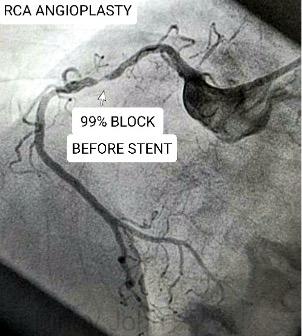
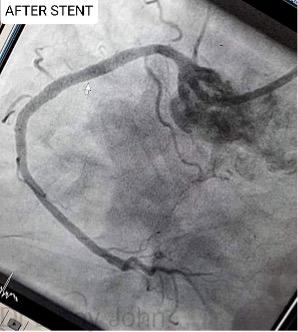
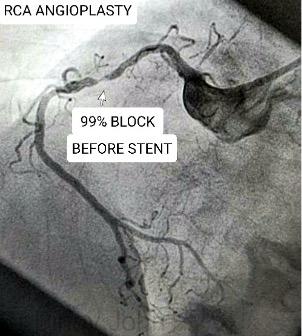
Once the artery is engaged, a wire is passed through the catheter to cross the block. Thereafter, a balloon is taken over the wire and placed across the block. The balloon is then inflated from outside with an in-deflator to open the block. (See image)
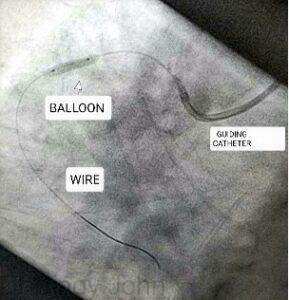
The balloon is then removed. After balloon dilatation, a stent, which is a tubular mesh, often coated with a medication has to be deployed across the block to prevent a re-block. The stent which comes pre-mounted on a balloon is advanced over the wire and positioned across the block. (See image)

When the balloon of the stent is inflated the stent gets apposed across the block on to the inside of the artery. The outward radial strength property of the stent keeps the stent open and keeps it well apposed to the arterial wall. (See image)
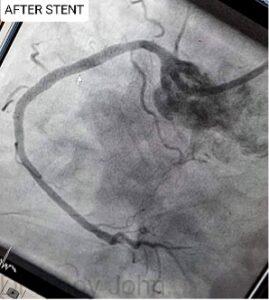
After the stent is deployed, the balloon is removed. Thereafter a larger balloon is often used to make the stent larger and get the stent better apposed to the arterial wall. Once a good result is confirmed the balloon, the wire and guiding catheter are removed from the artery. The sheath on the hand or leg is removed last. Usually the patient is discharged after 24 to 48 hours, depending on the complexity of the procedure and the course in the hospital, after an over-night observation in the coronary care unit. It is always safer for the patient to be in-hospital for at least 36 hours after the procedure.
What are the types of angioplasties?
Coronary angioplasty can be in a single artery when it is called Single vessel angioplasty or it can be in multiple arteries when it is called Multi-vessel angioplasty. When it is performed on calcified blocks it is a more complex procedure called Rotablation angioplasty and when it is performed in a patient with an ongoing heart attack it is called a Primary angioplasty. There are various other complex angioplasties which are detailed in the respective sections.






